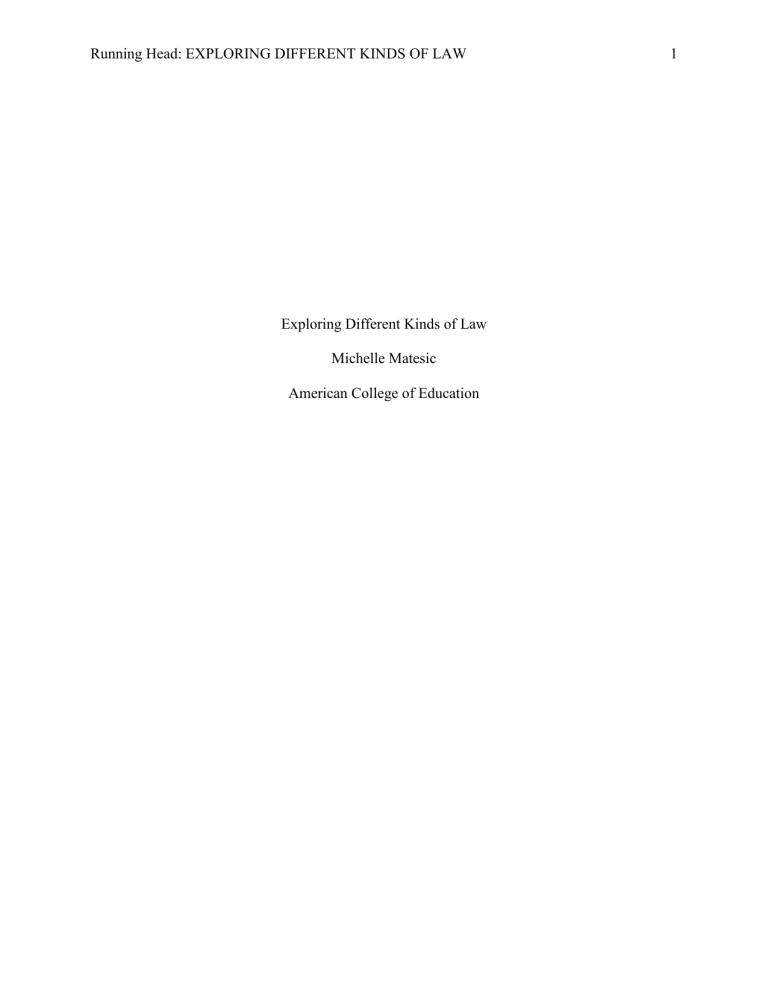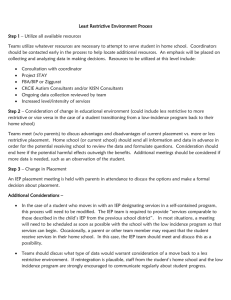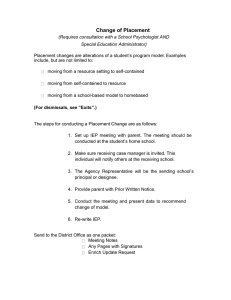
Running Head: EXPLORING DIFFERENT KINDS OF LAW Exploring Different Kinds of Law Michelle Matesic American College of Education 1 EXPLORING DIFFERENT KINDS OF LAW 2 Exploring Different Kinds of Law Meeting the needs of students is a core value of all schools. Identifying and placing students with special needs in the most appropriate learning environment to meet their individual needs is a necessity for any district, school, administrator and teacher. There are a set of strictly enforced timelines and procedures that must be done in order to keep the needs of the student in the forefront and as the sole purpose of possible special education classification. Special Education Law and Policies The beginning of this process is identifying students that may need extra services to allow them to reach their fullest potential. Whether that be keeping the students in the regular education class with their non-disabled peers or placing the student in a replacement setting like a resource room for certain subjects or having the student removed from the general education setting altogether and placed in a self-contained classroom or for the students with the most needs an out of district placement. Each of these educational settings serve a purpose and each is meant to put the student in the most appropriate place for them to thrive and learn. The first step of identification is critical and sets the stage for all the procedures that follow. After a student has been referred to the child study team for evaluation by a teacher, parent or another professional there will be an initial meeting with all parties involved to discuss concerns and the reasoning for that referral. According to the New Jersey state guidelines for IEPs, the meeting must be held within 15 days of the referral. At this meeting the major decision will be if an evaluation is necessary or not. If the decision is for an educational and intelligence testing then the team must decide what types of testing will be used to determine special services eligibility. The Child Study Team then has 90 days to administer the agreed up testing in order to deem a child eligible for special services or not (New Jersey Department of Education, 2016). EXPLORING DIFFERENT KINDS OF LAW 3 In New Jersey, at a minimum, there must be an intelligence test administered by a school psychologist and an educational test administered by an LDTC (Learning Disability Teacher Consultant). The results of these tests will be compared an if a large enough discrepancy exists from a student’s natural ability to learn and their present level of education then that student may be eligible for special services under a learning disability classification. Other ways a student may become eligible for special education services can come from medical professionals. That may be for any attention disorders or other medical concerns that are deemed to affect the child’s learning. Students may also be classified with a “speech disorder” that affects their education. That testing would be administered under the expertise of a school speech therapist. There are times when a student may not meet these requirements for services but there is enough functional data acquired from class work and tests to allow the Child Study Team to classify a child. While this has happened in the past it is not used often and only as a last resort for a student that is clearly in need for services but is considered “border-line” on any of the tests. It is very clear in New Jersey law that students cannot be classified based on socioeconomic disparities or if English is a new or second language for them. A child’s upbringing or lack of support staff at home is not a means to classify them for special education. In order to be classified in New Jersey a student must have a bonified disability that is identified through testing, a doctor, or data from the classroom. After the testing is completed the Child Study Team will meet again to discuss the results. At this meeting the parent, child study team members, general education teacher, special education teacher and any other adults involved will meet to share the information gathered. The general education teacher will update the team on the how the student is doing class and the special education teacher will inform the parent about the programs available in school. The EXPLORING DIFFERENT KINDS OF LAW 4 special education teacher will also answer any questions the parent may have about the program in school. If a child is deemed eligible for services the parent must sign off on that classification. At that point, the team then can discuss recommendations for placement, as well as, any additional services that the student may require. Under federal law a child must be placed in the “least restrictive environment”. That meaning a child must be in a placement that is most appropriate for them. It is the burden of the district to show why they are removing a child from the general education setting and their nondisabled peers. This is not taken lightly and the discussion of a child’s placement is of utmost importance. As far as the levels of removal from the general classroom they will be listed from the least restrictive to the most. General Education classroom with no IEP (Non-disabled student) General Education classroom with IEP (specific modifications and/or accommodations) Resource Room (replacement for specific classes) Self-Contained classroom (replacement for all subjects) Out-of-District placement (Most restrictive/ student removed from school to a school that best meets their needs) As stated above, with each placement a student if further and further removed from their non-disabled peers. The goal of any professional or guardian for a child will be to get them back into the general education setting. While that may not always be the case, it is the standard that all Child Study Team members should be held. It is not uncommon for students who are removed from the general classroom into more restrictive settings like a resource room or selfcontained classroom to be able to move into a less restrictive environment after they have EXPLORING DIFFERENT KINDS OF LAW 5 success in that other setting. It is the responsibility of the educators involved to identify the students who have been improving and deciding if another meeting needs to be help to discuss a transition into a less restrictive placement. Not wanting a child to experience failure after success in their current placement, modifications and accommodations for that student will be discussed at that meeting to see if those could meet the child’s needs and allow for success in that new setting. If the setting the child is placed in is appropriate and no member of the Child Study Team call for a meeting then the next opportunity for the team to meet with the parent will be one calendar year for the initial evaluation meeting. According to New Jersey IEP Direct Group (2011), “State regulations require that, “annually, or more often if necessary, the IEP team shall meet to review and revise the IEP” and determine the student’s placement” (p. 8). At this meeting the team will discuss the child’s present level of performance in each content area, as well as, any other pertinent information that may be needed to decide the student’s placement for the next year. Under law a student must be reevaluated by the child study team, at least every 3 years, unless the child’s guardian signs off that a reevaluation is not needed. This tends to happen when a child is more than a year away from transitioning into middle school or high school. If a child is heading into 4th grade and is up for a reevaluation, the team and parent may decide to wait until they are in 5th grade to get updated testing results to aid in the transition process. That said, if a parent or team member wants the student to be tested both years that is something that can be discussed at the yearly evaluation meeting. Conclusion The appropriate placement of a student is critical for their educational, social and personal success. It is of the utmost importance to place students in the least restrictive EXPLORING DIFFERENT KINDS OF LAW 6 environment so that they may flourish socially and educationally in a classroom that meets all their needs. “It takes a village” in a homage that spotlights the importance of a group in raising young minds. It is also a central theme in education. Parents and professionals coming together with the sole purpose of putting a child in the best scenario to breed success. It is essential for all those involved, including administration, to be aware and promote this mindset when dealing with the neediest students. EXPLORING DIFFERENT KINDS OF LAW References New Jersey, Department of Education. (2019, March). New Jersey Department of Education Document Informing LEAs, in Accordance with 20 U.S.C. §1407(a), of State-Imposed Rules, Regulations and Policies Not Required by IDEA or Federal Regulations. Retrieved May 26, 2019, from https://www.nj.gov/education/specialed/rules.pdf New Jersey IEP Direct Centris Group. (2011). New Jersey Special Education Compliance and Best Practices. Retrieved May 26, 2019, from https://www.gcsssd.org/ourpages/auto/2011/10/6/49484878/IEPD_NJ_WhitePaper_v1_IEP Process and Development.pdf 7



